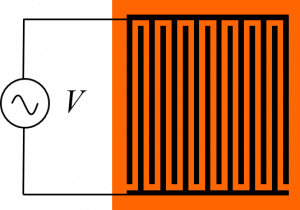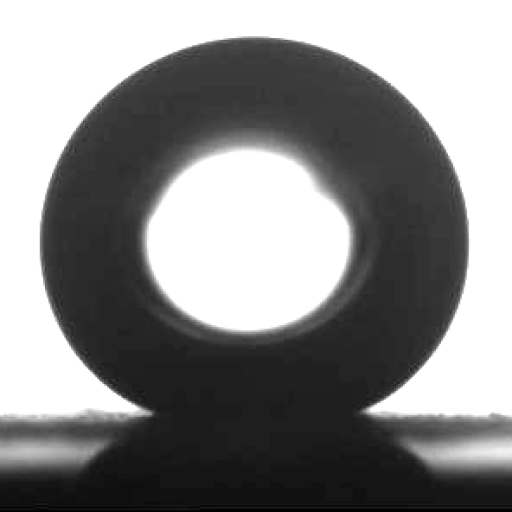Shaping Liquid Films
We have already seen here that electric fields can be used to create liquid films on phobic surfaces and that turning off the electric field results in the film recoiling into a droplet. We can go further than this and design electrodes such that we create an electric field that is shaped into a geometric pattern. This allows us to create liquid films that are also shaped in unusual geometric patterns.
Probably the simplest example to illustrate the idea is to use interdigitated electrodes:

A small amount of liquid placed on a surface above the electrodes will be drawn into a linear stripe along the length of the electrodes. When the electric field is removed (by turning the voltage off), the stripe will retract into a single droplet. If the field is reduced but not removed, the stripe will start to retract but doesn’t create the same shaped droplet that occurred without an electric field. Both side and top views of this can be seen in the video below. In this video, the electrodes below the surface on which the film has been formed are transparent and can’t be seen.
If we have electrodes defining a square pattern for the electric field, we can draw a liquid into a square-shaped film. When the voltage is switched off, the electric field is removed and the film contracts into a circular shape at the centre of the square. A top view of this can be seen in the video below. Again, the electrodes below the surface are transparent and can’t be seen.
However, when the voltage is reduced but not removed entirely, the electrode pattern affects how the liquid retracts. Also, the final droplet wets the surface to a greater extent than that which would occur due to the natural phobicity of the surface. This leads to the film retracting into interesting shapes, as can be seen below.
We are not restricted to electrodes defining square patterns for electric fields though. The video below shows a liquid film on a pattern of electrodes forming a semicircular pattern for the electric field. The film retracts when the voltage is removed and can be seen to dewet into a circular shape in the centre of the image. In this video, the electrodes just below the surface can be seen but the liquid is always wetting a flat surface above the electrodes. There aren’t any grooves in the surface that the liquid can follow.
If we have a similar film and surface but only partially reduce the voltage, the film dewets into a shape much nearer the edge of the semicircle, as seen below.
More complex shapes can be created if less fluid is placed on the surface, as can be seen in the video here. In this case, there isn’t enough fluid to fill the whole of the semicircular area.
Publications
- Not spreading in reverse: The dewetting of a liquid film into a single drop A.M.J. Edwards, R. Ledesma-Aguilar, M.I. Newton, C.V. Brown and G. McHale, Science Advances 2 (2016) e1600183
- Electrostatic control of dewetting dynamics, A.M.J. Edwards, R. Ledesma-Aguilar, M.I. Newton, C.V. Brown and G. McHale, Appl. Phys, Lett. 116 (2020), 253703
